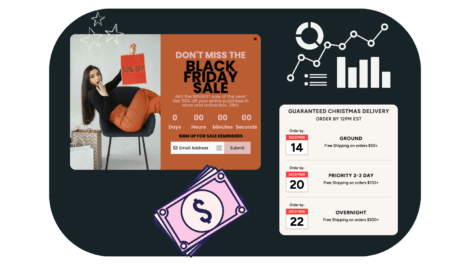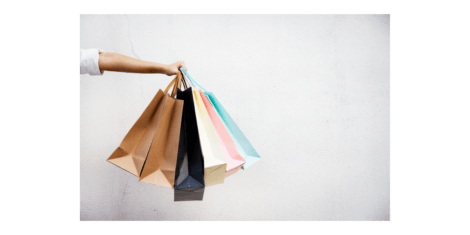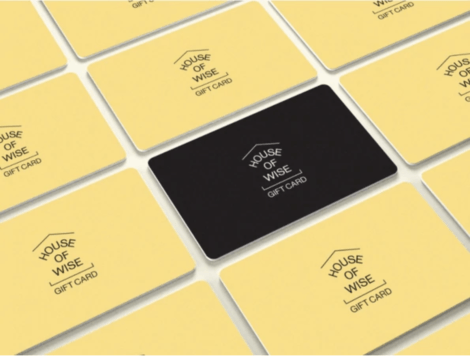The holiday season — retail’s version of the Super Bowl is a make-or-break time for most companies. Throughout the years, it’s increasingly crept into fall, unofficially starting with Halloween and culminating in New Year’s, becoming a marathon for marketers and consumers alike.
This growing holiday season means you’ll need to create months of holiday promotions, assets, and relevant experiences, all seamlessly connected across channels, online, and in-person.
Sounds overwhelming, right? Well don’t panic!
The key to holiday success is early planning, contingencies to keep your company agile, and personalization. This blog post will take a deep dive into top holiday marketing strategies to set you up for success during this critical sales period and ways to sustain it post-holiday through loyalty.
What To Keep In Mind When Planning Your Holiday Marketing
While BFCM has become synonymous with deep discounts and cut-rate prices, a race to the bottom isn’t necessarily a good thing for your bottom line. By constantly offering killer deals, you condition your audience to only buy when a sale is on, which over time, erodes margins and brand value.
While discounts are great (and huge ones have their place for sure, i.e. Fashion Nova’s 50-90% off flash sale)–you’ll need to take a more strategic approach to stand out and sustainably succeed in this competitive retail market.
Omnichannel Marketing
As online shopping overtakes traditional brick-and-mortar retail, you’ll need to bridge the gap between “brick and click.” Consistency across the digital and physical spaces is key and should be reflected in social media, email marketing, in-app, etc, to create a more enjoyable shopping experience.
Re-targeting and re-engagement both require coordination across channels, whether it’s win-back campaigns through emails or re-targeting on social media.

Personalization
Personalization is a must in this digital age where shoppers want a tailored experience. Even something as simple as adding their name to an email’s subject line can increase open rates by 18% but don’t forget to experiment with other customer data points, such as individual preferences or messaging related to past purchases and browsing.
Loyal Customers
The 80/20 rule is alive and well: 20% of your customers make up 80% of your revenue (or more). Be sure to craft strategies around building long-lasting relationships, using incentives like bonus points, free samples, surprise level-ups, exclusive offers, and more. These will help cement their emotional connection towards your brand and in the long-term, boost their CLV.
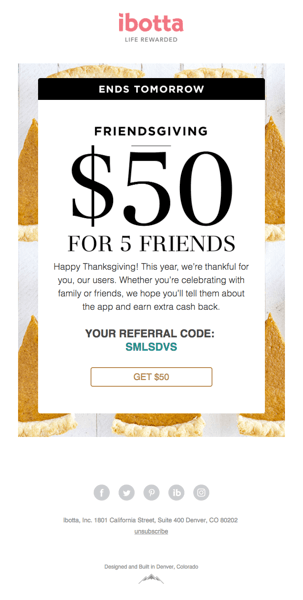
The Reason for the Season
The holidays are often associated with being a time to come together with loved ones and celebrate. This makes them a prime time to use nostalgia marketing and other content marketing strategies, which can be done in a variety of ways:
User-Generated Content: UGC helps put a face to your brand, showcasing happy customers and letting visitors imagine themselves in their shoes. Sometimes you aren’t just selling a product, but a story or memory.
For example, a mixer during the holidays can mean so much more than cooking, i.e., time with family, passing down traditions, and special memories. Use relatable stories like these in your marketing to evoke a powerful emotional connection. Research has shown that social media plays a huge role in the pre-purchase stages, and UGC is the ideal candidate for this content.
A Series of Things: Does The 12 Days of Christmas or 8 Days of Hanukkah ring any bells? These are examples of set series. You can use the same strategy in content, creating messages your subscribers will come to expect and look forward to. For example, last year, we created an interactive December holiday calendar modeled after the idea of an Advent Calendar. While a more advanced use case, we built this entirely using Justuno (which was pretty awesome if we do say so ourselves).
Be Thoughtful: The holidays mean something different to everyone, and for many, have a deeper meaning than simply big sales and a brand’s bottom line. Thoughtful messaging is a best practice for this time of year, and don’t forget that it’s just as important to consider the role holidays, your products, and more play in customers’ lives as much as your sales goals.
Tried-and-True Promotional Strategies
Combat the fatigue of an ever-longer holiday season by changing your promotion strategy throughout these months:
A Slow Build Up
Don’t go all out with a huge deal at the beginning–you’ll have nothing left to offer later on in the season. Early on, it’s best to target high-intent shoppers with messaging that drives urgency. This segment includes those who have abandoned a cart in the time leading up to October/November, added items to wish lists, or repeatedly visited your website.
High-intent shoppers only need a small incentive since they already want to buy and may just need a little nudge to complete their purchase. Try to close these sales early with an offer that’s a little lower than what you’re planning for BFCM (like a free gift or 10% off instead of 20%).
Simple Is Best
Cut out extra steps during BFCM to increase conversions. A shopper’s goal during this time is to save on their purchases, and asking for their email will only interrupt their experience. This means avoiding lead captures, gamification, etc.
Our customers saw engagement on spin-to-wins drop to 6.5%, almost half of their usual rate. This normally high-converting pop-up shows how more steps equals less engagement during this time.
Also, try to keep your offers simple and don’t have elaborate rules or thresholds–they’ll only create confusion and additional boundaries to purchase completion.
What You’re Offering
Incentivize conversions beyond just offering a standard percent or dollar-off promotion. Bundles, gifts, or free expedited shipping are just a few of the options when trying to think outside the box.
Pro Tip: Free samples are great because you’re able to introduce customers to a new product they may never have known about while driving demand later on! It’s also a great way to reduce “closeout” stock as you gear up for a new year.
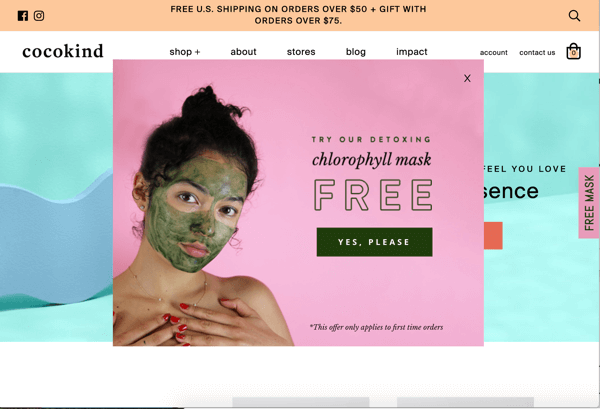
Down To The Wire & Panicking?
There’s always the good old flash sale! They move inventory fast, give a quick sales boost, and are an attention-grabbing headline indeed.
Product Recommendations
Product recommendations are one of the best ways to personalize a shopper’s experience and present them with an engaging shopping experience. Recommendations are complicated by the fact that many consumers are shopping for others, which alters their browsing and buying patterns.
Regardless, they are a must-have for every seller to combat the sensory overload of the holidays and help new visitors find what they’re looking for (or give them new ideas).
Best-Sellers
Highlighting your most popular products is the easiest form of recommendation. These are an easy-win for first-time visitors who are less familiar with your brand or aren’t searching for a specific item. Also, consumers are more likely to buy something that lots of other people have because of the influence of social proof, and our human desire to do something because others do.
New Arrivals
These work for loyal customers and new customers since they provide a fresh option to those who’ve shopped with you before and an opportunity to appeal to newly acquired traffic.
Cross-Selling & Upselling
Spotlight other products that are either complementary to what a visitor is browsing, or are similar in case they haven’t found the right item yet. This is also a great post-purchase messaging opportunity down the line to re-engage a customer to place a subsequent order. Order tracking pages are tracked an average of five times between purchase and receiving their items–make sure to maximize its potential for retention & personalization with related items to what they ordered to start building future interest.
Behavior-Based
If you’re using technology that tracks visitor behavior to build individual profiles (like Justuno), you can start to personalize recommendations based on the data from every click, scroll, or hover. Wishlists, purchase or browsing history, engagement levels, lifecycle stage, and more can all take your recommendations to the next level. Product recommendations can take on many forms, but all are powerful, and the more data you can collect on your visitors, the more value you can drive.
Gift Guides
These are a great way to make it easier for consumers who are shopping but not set on what to gift yet. It helps newcomers quickly find products perfect for those on their list, and inspires loyal customers to purchase from a category they may not have noticed before. Use guides with targeted themes based on high-performing customer segments or interests like:
“Gifts for the fitness junkie, Gifts to the outdoorsman, Gifts for the Wine Connoisseur, etc.”
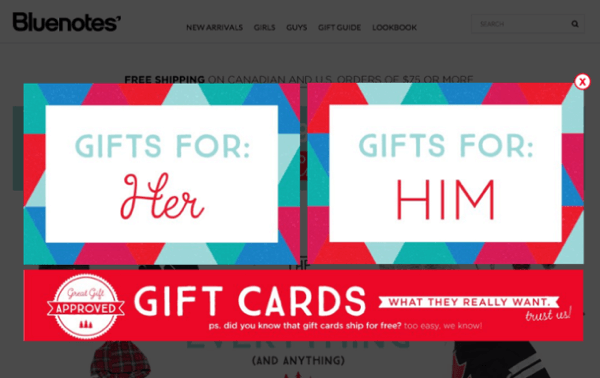
Gift Cards
When the time to ship has passed, and last-minute shoppers are scrambling–run a campaign promoting your gift card option. This works throughout the season as well for the unsure gifter but can really take off during the later dates.
Also a plus, you have two segments to target with re-marketing–the gifter segment (those who bought the gift card) with emails around other holidays throughout the year as someone who might be buying for another who likes your items. And the giftee segment (those getting the gift card), they’re likely a member of your target audience and perfect for turning into a repeat customer if you play your cards right.
Triggered Emails
Set up email triggers to combine the ease of automation with a personal touch for a huge revenue boost from email marketing during the holidays.
These emails are set up to be triggered by an action, so as consumers move through their customer journey, they’re met with personalized touchpoints relevant to their recent behavior.
Of all the possible triggers, abandoned cart emails are by far the most important. During the holiday season, abandoned carts are especially high, and these emails with highly relevant content are almost guaranteed to have high click rates.
Some shoppers have come to treat carts as a pseudo-wishlist, adding items to their cart, then taking time to research and consider. Use product images to jog their memory (remember they’re shopping a lot during this time) and to drive desire. You don’t just have to use triggered emails, these messages work well with SMS, push notifications, and app notifications as well. Create flows using the channel best suited for each shopper.
A similar triggered message would be the browse abandonment email, still a high-intent audience but not necessarily as primed to purchase. They’re still in the early stages of their customer journey, so take a more laid-back approach with your messaging. Aim to stay top of mind, but not overly pushy or invasive with your reminder.
Post-purchase messaging is another highly engaging example, with high open and click rates. Use this as a chance to start building a relationship, thanking them for their order, and provide something of value like ways to use their new item or great reviews to get them excited. Resist the urge to immediately try to sell them again, save that for later on in the new year.
After The Dust Settles
Just because the main events are over and the year is coming to a close doesn’t mean it’s time to relax! During the week of limbo between Christmas and New Years, 68% of consumers are still shopping. Whether it’s post-holiday inventory sales, wanting to use their new gift cards, or returning gifts for what they really wanted–there are more sales to be made.
Once you’re ready to sit down and take stock of how your season fared, you can review newly acquired customers and find those most likely to become repeat buyers. Like we stated earlier, many of these newly acquired customers are different from your typical audience and may never return (but that’s okay!).
Start re-targeting and nurture campaigns designed to bring these potential repeat buyers back to your site and continue building these new relationships–there are nine months until we do it all again!
Final Thoughts
The holidays are a massive opportunity for businesses that utilize it well, crafting relevant experiences that deliver all season long, and designing campaigns that protect their margins (high sales volume only means so much when accomplished with low margins).
Otherwise, you’ll end up with a lot of discount-chasing, one-time customers who cost more to acquire than they’ll end up purchasing.
Keep these tips in mind as you begin building out your holiday strategy, and you’ll be sure to have a banner year, both this year and beyond.
Want to check out more holiday content? Our BFCM corner has fresh content added weekly all season long!

